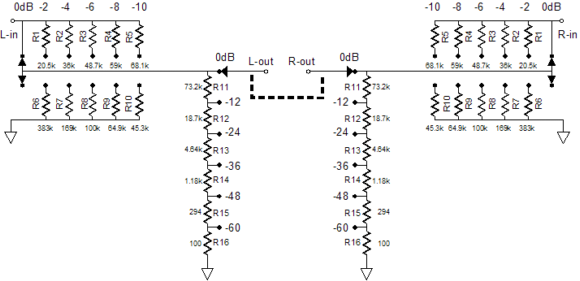In my amp switcher thread, the idea of a source, amp and/or pre-amp comparison box was mentioned. I built the amp switcher for comparing integrated amps (or amps with separate pre-amps or amps with exactly the same gain) so I didn't address differing levels, just switching and safely handling the amps.
Naturally, a pre-amp comparison box could just be a line-level switch box (are there tube pre-amps that need a load all of the time like some of the tube amps?).
A source comparison box could just be a switch box (or your pre-amp) too, if it wasn't for that pesky different output level issue. If you happen to have a pre-amp that allows you to pad the input levels individually (I know some Meridians can and I'm sure other digital units can) then you could use that.
For comparing amps of different gain levels with a single pre-amp, the situation is similar to the source comparison scenario. Naturally, having two identical pre-amps negates the level problem, but unless you make the products, you probably don't have identical pre-amps just sitting around.
So basically you need a switch box with level adjustment. Since putting an attenuating circuit in-line with only one side would bias the comparison, you have to put it (and use it) on both sides. This sounds like a switch box with a couple of attenuators (pots, stepped, whatever).
So, is a pot good enough? Does such a device call for a stepped attenuator? Stepped attenuators can get expensive, particularly two of them. It's those darn specialized switches - no one in the real world has a need for a two deck, 24+ position switch. They are niche items that often cost $100+ for just a bare switch.
So mgalusha turns me on to this idea:
http://www.tubecad.com/2007/04/blog0102.htmDirect image link:

It's a hybrid ladder/series stepped attenuator that uses three 6 position 2 deck or pole switches. He doesn't sell the kits anymore - looks like he did one run and sold out of them. It effectively gives you a 36 step attenuator using easily available and inexpensive switches. In fact, there are pretty readily available 12 position 2 deck switches that can be used for this (OMG - 144 position attenuator for under $50!!!) Wait, there's more - it also give you a quality balance control.
It's slightly tricky to calculate the ladder values because the ground side is in parallel with the series attenuator, but more on that in a minute.
So, let's say you buy into this inexpensive stepped attenuator approach and don't mind soldering a few dozen resistors. Then you've got a switch box with level attenuation.
But Brad, you say, what about the impedance issues of a stepped attenuator in front of my precious amps. You'll ruin the delicate balance of the system. Oh the humanity!!! the humanity!!!
So, what about putting a unity gain buffer between the attenuators and the amps? This would address the impedance issue, but could mask the true behavior of the output stage of the source. In such a device, I don't think we can achieve the purity that a simple switcher allows, but we can try to stay a good as possible and assume that one will always directly attach the system to see if their comparison thoughts hold true.
Here's one option for a discrete, unity gain buffer:
http://www.diamondstar.de/jisbos/jisbos_overview.htmlBorbely has a one too -
http://www.borbelyaudio.com/eb602403.aspAnd one could implement a number of data sheet reference designs for op-amp/IC buffers.
Naturally, there's the popular (at least on AC) Burson buffer, but it has gain and costs more than an option like the one above.
The relay/switch could be placed upstream of the buffer, so only one set would be needed in the device. One could then use the box with attenuation set to zero with a single source/pre-amp just to see how a unity gain buffer impacted the sound (possibly wiring it to allow for a switch between buffer and bypass instead of two sources, but I haven't even considered the wiring/routing/switching implications of that yet...).
I need to finish the spreadsheet, but I've got an Excel thing going that will calculate both the ladder and series portions of the hybrid attenuator. I'm not fancy enough to make it totally dynamic, but once I make one sheet, it should be easy to make additional pages to address 6 vs 12 step switches. BTW: If you just want to find a general spreadsheet for calculating stepped attenuators, this one is the best I have found:
http://gainclone.platenspeler.com/download/attenuator_publish.xls It even includes tables of common resistor values and automatically finds the closest ones and charts the actual attenuation vs theoretical.
So, questions for the group:
Am I crazy?
Do you have any experiences with a passive pre-amp/unity gain buffer setup to grant wisdom from?
Is mgalusha evil for planting this seed?

Don't ask me why - I'm not entirely sure I'm going to build it, but the idea got stuck in my head, so I at least have to put it on paper. We'll see how sticky the idea is - sometimes you have to build it to get the idea unstuck from your head.